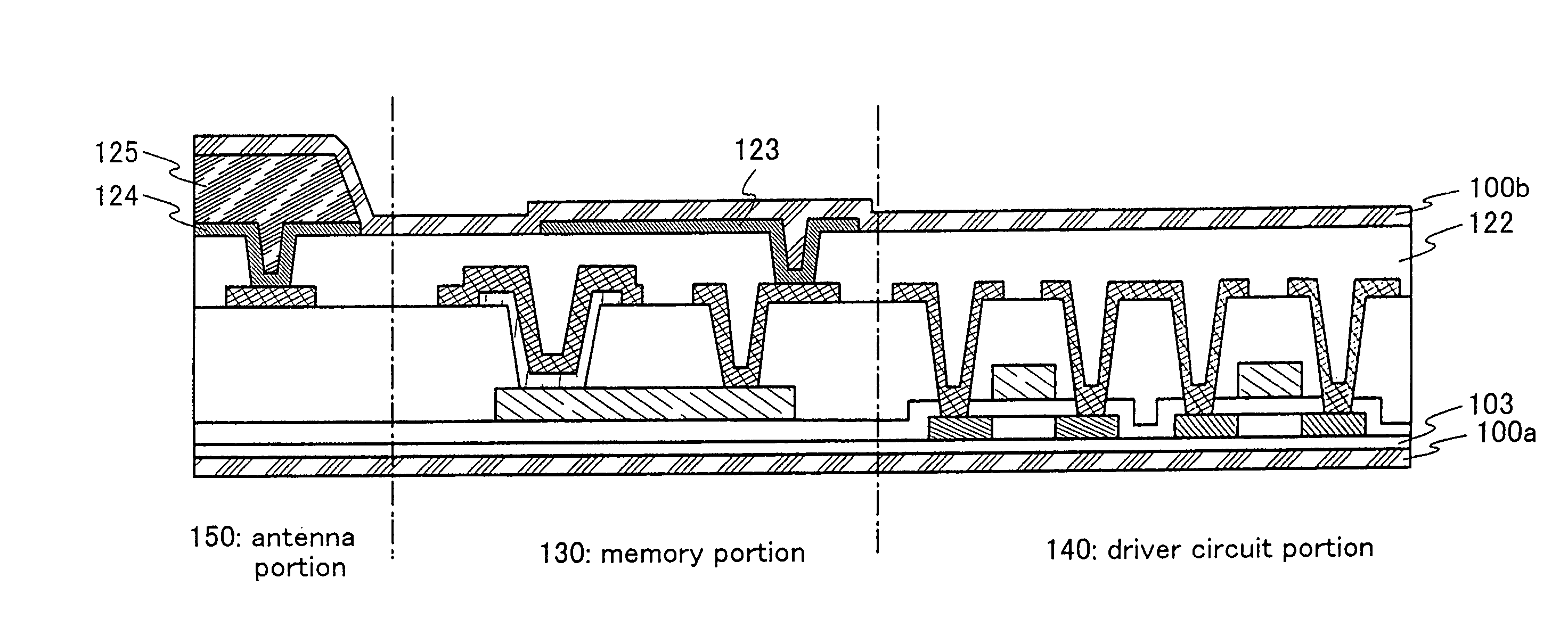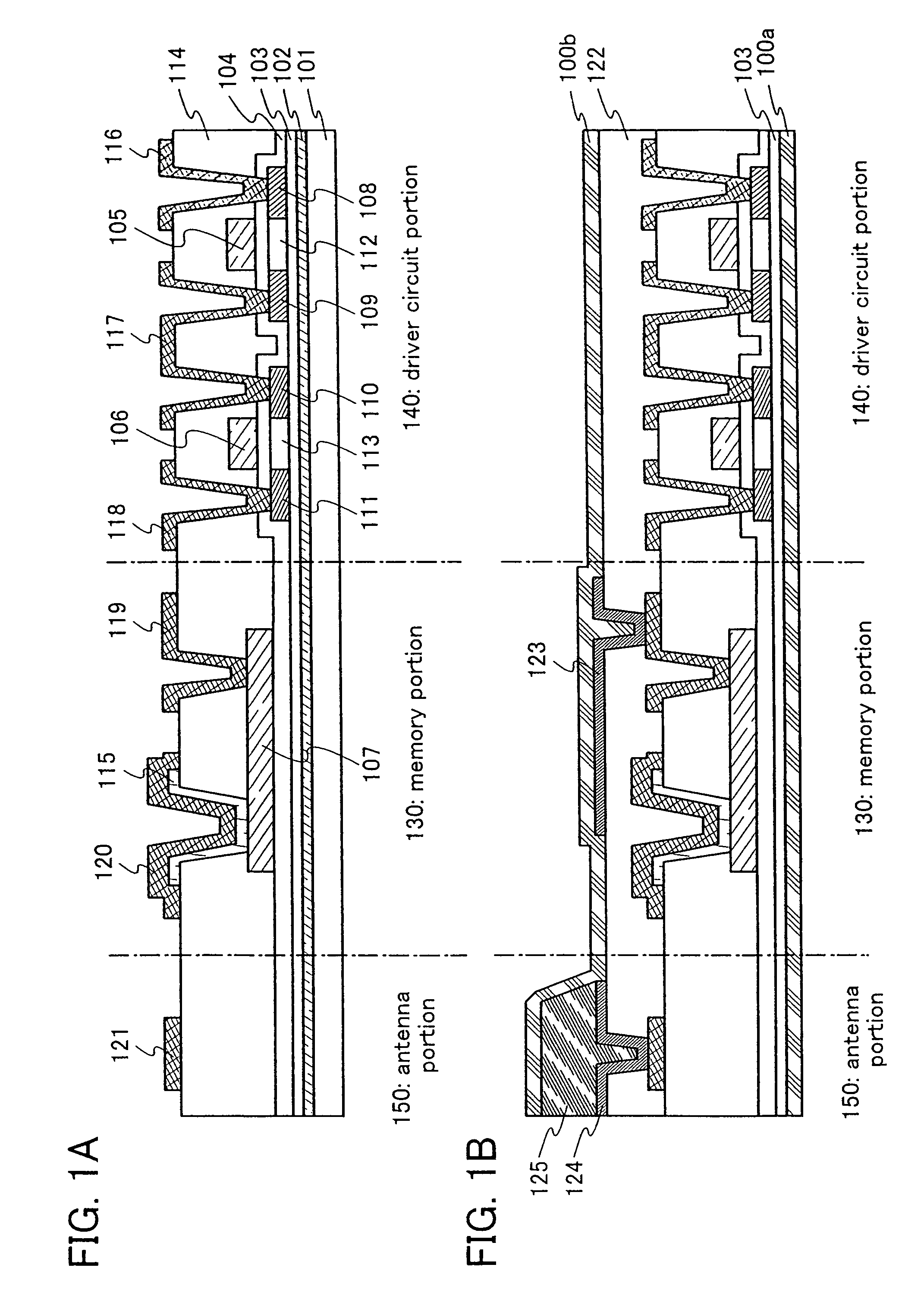Semiconductor device and manufacturing method thereof
a semiconductor and semiconductor technology, applied in the field of semiconductor devices, can solve the problems of increasing the mounting cost of silicon chips, the inability to adapt to the shape of the curved surface of the article, and the inability to reduce the unit cost of wireless chips, so as to reduce the plane area of the driver circuit of the memory, the effect of reducing the unit cost of the chip and reducing the voltage value of the signal obtained by the antenna
- Summary
- Abstract
- Description
- Claims
- Application Information
AI Technical Summary
Benefits of technology
Problems solved by technology
Method used
Image
Examples
embodiment 1
[0098]In this embodiment, a manufacturing method of a wireless chip including active matrix antifuse-type ROM will be explained below with reference to FIGS. 8A to 8D and FIGS. 9A to 9C.
[0099]First, a metal layer 502 which serves as a peeling layer is formed over a substrate 501. A glass substrate is used as the substrate 501. A tungsten film, a tungsten nitride film, or a molybdenum film with a thickness of 30 to 200 nm which is obtained by a sputtering method is used for the metal layer 502.
[0100]Next, a surface of the metal layer 502 is oxidized to form a metal oxide layer (not shown). The metal oxide layer may be formed by oxidation of the surface with pure water or ozone water or oxidation with oxygen plasma. Alternatively, the metal oxide layer may be formed by heating in an atmosphere containing oxygen. Further alternatively, the metal oxide layer may be formed in a later step of forming an insulating film. In this case, when a silicon oxide film or a silicon oxynitride film ...
embodiment 2
[0140]In this embodiment, an example in which a process is partly different from that of Embodiment 1 will be shown in FIGS. 10A to 10D and FIGS. 11A to 11C. Note that portions which are common to those in Embodiment 1 are denoted by the same reference numerals, and the same explanation is omitted for simplification.
[0141]First, the same cross-sectional structure as FIG. 8A is obtained according to Embodiment 1. Note that FIG. 10A is the same as FIG. 8A.
[0142]Next, a silicon film is formed by a sputtering method, an LPCVD method, a plasma CVD method, or the like, and a metal film is stacked thereover by a sputtering method or a plasma CVD method. Any one of an amorphous silicon film, a microcrystalline silicon film, and a polysilicon film is used as the silicon film. A thickness of the silicon film is 10 to 200 nm. The metal film is formed using a simple substance such as titanium, tungsten, nickel, chromium, molybdenum, tantalum, cobalt, zirconium, vanadium, palladium, hafnium, pla...
embodiment 3
[0162]A semiconductor device of this embodiment will be explained with reference to FIG. 12. As shown in FIG. 12, a semiconductor device 1520 of the present invention has a function of performing noncontact data communication. The semiconductor device 1520 includes a power supply circuit 1511, a clock generation circuit 1512, a data demodulation / modulation circuit 1513, a control circuit 1514 which controls other circuits, an interface circuit 1515, a memory circuit 1516, a data bus 1517, an antenna 1518, a sensor 1523a, and a sensor circuit 1523b. In FIG. 12, a driver circuit refers to the power supply circuit 1511, the clock generation circuit 1512, the data demodulation / modulation circuit 1513, the control circuit 1514 which controls other circuits, and the interface circuit 1515.
[0163]The power supply circuit 1511 generates various power supply voltage to be supplied to each circuit in the semiconductor device 1520, based on an AC signal inputted from the antenna 1518. The clock...
PUM
 Login to View More
Login to View More Abstract
Description
Claims
Application Information
 Login to View More
Login to View More - R&D
- Intellectual Property
- Life Sciences
- Materials
- Tech Scout
- Unparalleled Data Quality
- Higher Quality Content
- 60% Fewer Hallucinations
Browse by: Latest US Patents, China's latest patents, Technical Efficacy Thesaurus, Application Domain, Technology Topic, Popular Technical Reports.
© 2025 PatSnap. All rights reserved.Legal|Privacy policy|Modern Slavery Act Transparency Statement|Sitemap|About US| Contact US: help@patsnap.com



